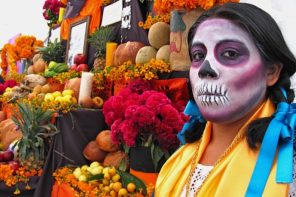It’s that time of year again. Shoppers are looking for gifts, It’s a Wonderful Life is starting its endless loop on television, families are making plans to come together for the traditions that mark the season, and the pervasive awareness that another year has passed is creeping into our collective consciousness.
For as long as I can remember, the buildup to the New Year in holiday media coverage has included one particularly poignant element that now, as I come ever closer to 50 years old, haunts me more than arouses curiosity—the rollout of the year’s important deaths.
The lists this year are noting the deaths of Joe Frazier, Steve Jobs, Amy Winehouse, Bubba Smith, Andy Rooney, Clarence Clemons, Geraldine Ferraro, and many others—some rich, some poor; some famous, some rather obscure; some young, some really old.
So why do the dead crash the holidays, year after year?
I do not know the longer history of these year-end death lists, or why media both old and new have embraced this annual practice. The lists are neither exhaustive nor comprehensive—most of them are cultural repositories of once living people who are no longer, ghosts now brought to the public eye and representing… what? Fame? Accomplishment? Impact? Tragedy? All these are relevant, no doubt.
Sacred Roll Call
But there is something more going on here than simply taking a moment to recall past lives of people we may or may not have heard of before reading about their deaths on the list. Bringing the so-called notable dead to mind annually is nothing if not religious ritual—not religious in the sense of the Christian faith or the Jewish faith or the Buddhist faith, but religious in another sense. More cultural than faith-based, the sacred practice of creating a yearly roll call of certain deceased individuals who now are gone caters to religious sensibilities that are no longer adequately addressed for many Americans in their church, synagogue, temple, or other place of worship.
What are some of these religious sensibilities? First and most fundamentally, they force us to confront our own mortality, and offer frames of meaning to make sense of death. The point of all religion, many have said, is to find ways to transcend the reality all must face. The faces of the dead brought each year to public consciousness, lined up in a row, enumerated in lists, bear a vivid and unmistakable message: memento mori, remember death, and that you too will die.
And yet the year-end dead lists are not macabre, recalling no traces of the transi, or rotting corpses, or skulls so popular in Christian history, as well as in other cultures. Instead, they are lighter, fleshed-out images of notable people in life—at an awards show, or posing for a portrait, or in a moment of triumph or contentment—who we are being asked to remember as dead, as another year passes and the world continues to turn without them.
Of course this is not a media-directed moment for philosophical, existential reflection on the meaninglessness and absurdity of life in such transient conditions. No, the religious payoff is more practical and comforting: all of us who read these lists are unified, brought and bound together, by our shared attention to the memory of certain strangers whose lives were notable enough to make it on the list and who are simultaneously celebrated and mourned.
What Counts in Life
Even more religiously useful is how these dead, and our temporary fixed attention to them, reinforce the shared values and morals that animate the social body. One sign of success is leaving your mark on society, making an impact; being famous brings you out of the anonymous masses and bestows celebrity, a status that affords you to an afterlife that most will never achieve; individual biographies of lives lived are more compelling than questions of postmortem judgment or the possibility of reincarnation—these lists of the dead convey profound lessons about what counts in life to the living in twenty-first century America.
And nothing teaches a profound moral lesson like a corpse.
The flipside of our maniacal obsession with zombies, the year-end notable death lists are a domesticated yet sacred ritual of acknowledging and, yes, even honoring the dead—though without the reminder of the truly repulsive details associated with bodily disintegration.
The lists are a form of transcendence, a way to imagine that there is something more to death. They bring some of the dead once more to life to teach lessons about mortality, bring us momentarily together through deathly sentiments, and inculcate common values and moral frames that can help us make sense of and live with death.



